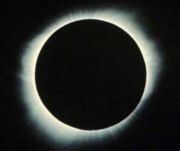Lancelin: Total Solar Eclipse
| Revision as of 07:53, 11 April 2007 (edit) Paul (Talk | contribs) ← Previous diff |
Revision as of 07:55, 11 April 2007 (edit) Paul (Talk | contribs) Next diff → |
||
| Line 1: | Line 1: | ||
| <BR> | <BR> | ||
| - | [[Image:1974 eclipse.jpg|left|thumbnail|180px|Total eclipse observed at Hamelin Bay;<BR> 350 Km south of Lancelin: ''Photo - Mick Wolf'']] | + | [[Image:1974 eclipse.jpg|left|thumbnail|180px|Total eclipse observed at Hamelin Bay;<BR> 350 Km south of Lancelin:<BR> ''Photo - Mick Wolf'']] |
| [[Image: Solar rocket.jpg|right|thumbnail|100px|Original launcher and full scale model of rocket at Bullcreek Aviation Museum: ''Photo – Kerrie Dougherty'']] | [[Image: Solar rocket.jpg|right|thumbnail|100px|Original launcher and full scale model of rocket at Bullcreek Aviation Museum: ''Photo – Kerrie Dougherty'']] | ||
| - | + | <BR><BR><BR> | |
| In June 1974 a total solar eclipse occurred over the south-west corner of Western Australia. A team of US scientists and engineers from '''Sandia Laboratories''' arrived in Lancelin 125 km north of Perth with a van, a tracking antenna, two launch pedestals and two 2-stage '''Terrier-Sandhawk''' rockets to launch their experiments during the total eclipse. | In June 1974 a total solar eclipse occurred over the south-west corner of Western Australia. A team of US scientists and engineers from '''Sandia Laboratories''' arrived in Lancelin 125 km north of Perth with a van, a tracking antenna, two launch pedestals and two 2-stage '''Terrier-Sandhawk''' rockets to launch their experiments during the total eclipse. | ||
| These rockets carried a telemetry package and a '''photo data acquisition module''' to record the Sun’s coronal temperature distribution by observing the '''Lyman-alpha''' line width. This could only be done for the short time the rockets were above the Earth’s atmosphere. | These rockets carried a telemetry package and a '''photo data acquisition module''' to record the Sun’s coronal temperature distribution by observing the '''Lyman-alpha''' line width. This could only be done for the short time the rockets were above the Earth’s atmosphere. | ||
| + | |||
| [[Image:eclipse map.jpg|left|thumbnail|180px|Umbra (total shadow) dark grey arc; penumbra (partial shadow) mid grey area:<BR>''Image - HM Nautical Almanac Office'']] | [[Image:eclipse map.jpg|left|thumbnail|180px|Umbra (total shadow) dark grey arc; penumbra (partial shadow) mid grey area:<BR>''Image - HM Nautical Almanac Office'']] | ||
| + | |||
| The rockets were successfully launched in view of a small group of spectators at 13.11 West Australian time and reached a height of 320 km. A little while later the telemetry technicians, on a recovery boat, winched the research packages out of the sea off the Lancelin coast. | The rockets were successfully launched in view of a small group of spectators at 13.11 West Australian time and reached a height of 320 km. A little while later the telemetry technicians, on a recovery boat, winched the research packages out of the sea off the Lancelin coast. | ||
| A display of the launcher and a ‘dummy’ rocket can be seen at the Bullcreek Aviation Museum, near Perth. | A display of the launcher and a ‘dummy’ rocket can be seen at the Bullcreek Aviation Museum, near Perth. | ||
| - | |||
| - | |||
| ---- | ---- | ||
| '''Return''' to [[Western Australia in Space|WA in Space]] | '''Return''' to [[Western Australia in Space|WA in Space]] | ||
Revision as of 07:55, 11 April 2007
In June 1974 a total solar eclipse occurred over the south-west corner of Western Australia. A team of US scientists and engineers from Sandia Laboratories arrived in Lancelin 125 km north of Perth with a van, a tracking antenna, two launch pedestals and two 2-stage Terrier-Sandhawk rockets to launch their experiments during the total eclipse.
These rockets carried a telemetry package and a photo data acquisition module to record the Sun’s coronal temperature distribution by observing the Lyman-alpha line width. This could only be done for the short time the rockets were above the Earth’s atmosphere.
The rockets were successfully launched in view of a small group of spectators at 13.11 West Australian time and reached a height of 320 km. A little while later the telemetry technicians, on a recovery boat, winched the research packages out of the sea off the Lancelin coast.
A display of the launcher and a ‘dummy’ rocket can be seen at the Bullcreek Aviation Museum, near Perth.
Return to WA in Space



